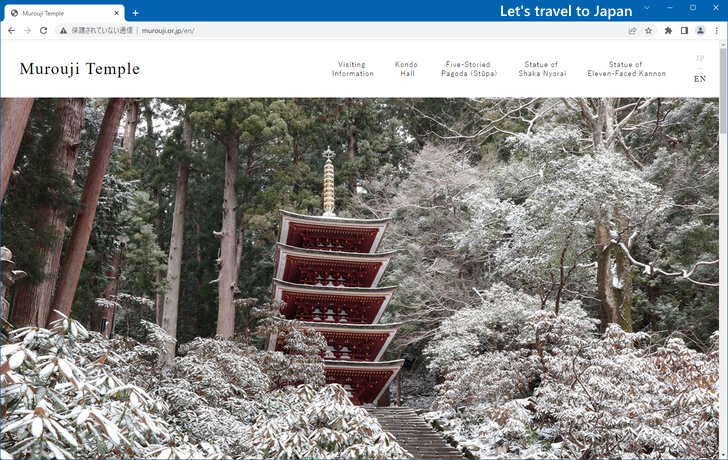Highlights and access methods of Muroji Temple (Nara Prefecture)
In this article, we will explain the attractions of Muroji Temple in Nara Prefecture and how to access it for those who are traveling to Japan from overseas.

(Last modified: )
(Prefecture : Nara , Category : Temples)
Table of contents
About Muroji Temple
Muro-ji Temple, located in Nara Prefecture, Japan, is a historic Buddhist temple founded in the 8th century. Nestled in a mountainous region, the temple is renowned for its serene atmosphere, ancient wooden architecture, and beautiful natural surroundings. It houses a five-story pagoda and several other significant structures, making it an important site for both religious and cultural enthusiasts. Throughout the year, Muro-ji Temple attracts visitors with its stunning seasonal displays, including cherry blossoms in spring and colorful autumn foliage.
Highlights of Muroji Temple
Muro-ji Temple, located in the mountainous area of Uda city in Nara Prefecture, Japan, is a captivating tourist destination for foreign visitors interested in Japanese history, culture, and spirituality. This ancient Buddhist temple, founded in the early 9th century, is also known as "Nyonin Koya" or "Women's Koyasan" because, unlike many other temples at the time, it allowed women to enter and practice Buddhism.
The temple's serene, mountainous setting provides a peaceful atmosphere that invites visitors to explore its rich history and architectural beauty. One of the most prominent features of Muro-ji Temple is its five-story pagoda, which is the smallest of its kind in Japan. This wooden structure, dating back to the Heian period (794-1185), showcases the elegance and craftsmanship of traditional Japanese architecture.
In addition to the pagoda, Muro-ji Temple features several other important structures, including the Main Hall, which houses a statue of Shaka Nyorai, and the Kondo (Golden Hall), home to an impressive array of Buddhist statues. Visitors can also explore various sub-temples and halls, such as the Miroku-do and the Oku-no-in, each with its own unique atmosphere and cultural significance.
While Muro-ji Temple can be visited year-round, the surrounding natural beauty is particularly enchanting during two seasons: spring and autumn. In spring, usually from late March to early April, the temple's cherry blossoms create a picturesque scene, while in autumn, from late October to early November, the vibrant colors of the changing leaves provide a stunning backdrop for the temple complex.
In conclusion, Muro-ji Temple is an alluring destination for foreign tourists seeking to immerse themselves in Japan's rich cultural history and spiritual traditions. The temple's serene environment, historical significance, and architectural beauty make it a must-visit site. Although it can be visited any time of the year, the captivating natural scenery during spring and autumn seasons adds an extra layer of charm to the experience.
Address and access method of Muroji Temple
Muro-ji Temple is located at 78 Muro, Uda City, Nara Prefecture 633-0112, Japan.
The nearest train station to the temple is Muroguchiono Station on the Kintetsu Osaka Line. From Muroguchiono Station, visitors can take a bus or taxi to reach the temple, which is approximately a 20-minute ride away. Additionally, the temple can also be accessed via a scenic walk through the mountainous terrain, taking about 60 minutes from the station.
Attractions near Muroji Temple
Several notable attractions are located near Muroji Temple:
Soni Highlands (Soni Kogen)
A picturesque area known for its beautiful grasslands and rolling hills, offering a variety of hiking trails and stunning views, particularly during autumn when the pampas grass turns a brilliant shade of gold.
Murou Akame Aoyama National Park
This expansive park features various hiking trails, waterfalls, and natural attractions, including the famous Akame 48 Waterfalls, a series of waterfalls and cascades revered for their beauty and spiritual significance.
Haibara Uchiwa Maki-e Museum
A museum dedicated to showcasing the traditional Japanese art of maki-e, a technique of decorating lacquerware with gold and silver powder. The museum also displays Haibara Uchiwa, a local type of round fan, and offers hands-on workshops for visitors to try their hand at maki-e.
Hase-dera Temple
Another historic Buddhist temple located in the nearby city of Sakurai, renowned for its main deity, an 11-headed Kannon statue, and beautiful seasonal flowers, such as hydrangeas and peonies.
Exploring these attractions in addition to Muro-ji Temple will provide visitors with a comprehensive and enjoyable experience of the region's natural beauty and cultural heritage.
Other information about Muroji Temple
Official site (English version) about Muroji Temple :

-- --
Thank you for reading to the end.
( Written by Tatsuo Ikura )